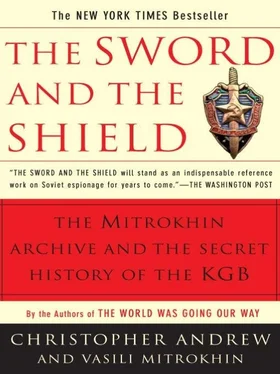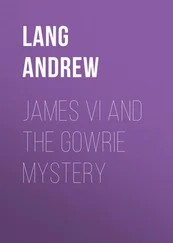People who are suitable as special [illegal] agents for Line F operations are 20 to 45 years old. Persons from aristocratic and bourgeois-conservative circles are of no interest. Preference is given to the following professions: electricians, mechanics, toolmakers, chemists, qualified engineers, technicians and highly skilled workers—primarily citizens of the United States, France, Canada, Britain, West Germany, Italy and Japan. People who adhere strictly to church dogma and rules are not suitable, nor are people with a tendency towards alcoholism, drug addiction and sexual deviations. In order to provide explanations for the characteristics and routines involved in the operations being carried out, it is desirable to select people who travel frequently around their own country as well as to other countries—people who own houses, second homes, country dachas, farmsteads and plots of land. 29
The Thirteenth Department’s preparations for wartime sabotage operations inevitably overlapped with those of the GRU. The resulting duplication of effort was made worse by the traditional rivalry and distrust between the two agencies. On April 7, 1960 the CPSU Central Committee issued Decision No. P-274-XIVI, calling for closer co-ordination between the KGB and GRU. This and other exhortations, however, had little practical effect. In September 1963 the Centre complained that the leadership of the GRU was making no serious attempt to co-ordinate its operations with those of the KGB. 30
The KGB found it easier to collaborate with the intelligence agencies of other Soviet Bloc countries, who were usually willing to accept a subordinate role, and sought their help in a number of Line F operations. According to Markus Wolf, head of the HVA (Stasi foreign intelligence) from 1952 to 1986, the Centre offered its allies lethal nerve toxins and poisons which were fatal on contact with the skin for use during “special actions.” Wolf claims that he refused all but a small supply of “truth drugs,” which he had analyzed by an HVA doctor:
He came back shaking his head in horror. “Use those without constant medical supervision and there is every chance that the fellow from whom you want the truth will be dead as a dodo in seconds,” he said.
In his memoirs Wolf seeks to distance himself from KGB assassination attempts. He claims, for example, that the KGB assassinated Aleksandr Trushnovich, the NTS leader in West Berlin, “while attempting to kidnap him.” 31KGB files tell a rather different story. In April 1954 Heinz Gleske, a Stasi officer operating undercover in West Germany, lured Trushnovich to his home, where he was kidnapped and handed over to the KGB at Karlshorst. Gleske then issued a statement, claiming that Trushnovich had become disillusioned with the West and had “voluntarily” defected to East Germany. The Centre awarded Gleske the Order of the Red Star. 32
Even with some assistance from its allies, the KGB’s “special actions” against NTS and OUN leaders during the Khrushchev era had a mixed record of success—not least because of the doubts of its assassins. In an attempt to disguise its involvement in an attempt to murder the NTS president, Vladimir Poremsky, the Thirteenth Department hired the services of a German contract killer, Wolfgang Wildprett. Like Khokhlov, however, Wildprett had second thoughts, decided not to go ahead with the “special action” and in December 1955 informed the West German police. In September 1957 a Thirteenth Department attempt to poison Khokhlov himself with radioactive thallium (chosen in the belief that it would degrade and leave no trace at autopsy) also failed.
These failures, however, were followed by the successful assassination of two leading Ukrainian émigrés: the main NTS ideologist, Lev Rebet, in October 1957 and the OUN leader, Stephen Bandera, in October 1959. 33The Thirteenth Department assassin in both cases, only twenty-five years of age when he killed Rebet, was Bodgan Stashinsky, who operated out of the KGB compound at Karlshorst. His murder weapon, specially constructed by the KGB weapons laboratory, was a spray gun which fired a jet of poison gas from a crushed cyanide ampule and caused death by cardiac arrest. The Centre calculated, correctly, that an unsuspecting pathologist was likely to diagnose the cause of death as heart failure. Stashinsky tested his weapon by taking a dog into a wood near Karlshorst, tying it to a tree and firing at it. The dog had immediate convulsions and died in a few moments. Confident of the deadliness of his spray gun, Stashinsky killed both Rebet and Bandera by lying in wait for them in darkened stairways. In December 1959, he was summoned to Moscow. At a ceremony in the Centre, Aleksandr Nikolayevich Shelepin, chairman of the KGB, read aloud a citation praising Stashinsky “for carrying out an extremely important government assignment” and presented him with the Order of the Red Banner. Stashinsky was told he would be sent on a course to perfect his English before being sent on a three- to five-year assignment in the West to carry out further “special actions.” 34
Like Khokhlov and Wildprett, however, Stashinsky had second thoughts about his career as an assassin, encouraged by his East German girlfriend, Inge Pohl, whom he married in 1960. In August 1961, the day before the Berlin Wall sealed off the escape route from the East, the couple defected to the West. Stashinsky confessed to the murders of Rebet and Bandera, was tried at Karlsruhe in October 1962 and sentenced to eight years’ imprisonment. The judge declared that the main culprit was the Soviet government which had institutionalized political murder. Heads were quick to roll within the KGB. According to Anatoli Golitsyn, who defected four months after Stashinsky, at least seventeen KGB officers were sacked or demoted. 35More importantly, the Khokhlov and Stashinsky defections led both the KGB leadership and the Politburo to reassess the risks of “wet affairs” (assassination attempts). Fearful of attracting more of the worldwide publicity generated by Khokhlov’s press conference and Stashinsky’s trial, the Politburo abandoned assassination as a normal treatment of policy outside the Soviet Bloc, resorting to it only on rare occasions such as in the elimination of President Hafizullah Amin of Afghanistan in December 1979. 36
Among the chief beneficiaries of the KGB’s declining enthusiasm for assassination plots was probably Nikita Khrushchev. Vladimir Semichastny, then the KGB chairman, claims that he was approached in 1964 by Leonid Brezhnev, the ringleader of the plot to oust Khrushchev, and asked to arrange his “physical elimination.” Semichastny refused. 37He did, however, agree to bug Khruschchev’s private telephone lines. With the KGB’s assistance, the plotters achieved a substantial element of surprise. When Khrushchev left for a holiday on the Black Sea in the autumn of 1964, he was seen off by smiling colleagues. When he returned on October 13, summoned to attend an urgent meeting of the Presidium, he was met at the airport only by Semichastny and a senior security officer from the KGB. “They’ve all gathered in the Kremlin and are waiting for you,” Semichastny told him. Khrushchev surrendered to the inevitable without a struggle, agreeing to resign on the grounds of “advanced age and poor health.” Thereafter, he was relegated almost to the status of unperson, not mentioned again in the press until Pravda published a brief note in 1970 recording his death. 38
THOUGH ITS ASSASSINATION operations declined, the Centre showed increasing interest during the 1960s and 1970s in collaboration with “anti-imperialist” guerrilla and terrorist groups in the Third World. In January 1961 Khrushchev publicly pledged Soviet assistance for “movements of national liberation.” The abortive, CIABACKED invasion of Cuba at the Bay of Pigs three months later strengthened his determination to do so. On August 3 he told a private meeting of Warsaw Pact leaders in Moscow, “I wish we could give imperialism a bloody nose!” 39The Centre believed it had devised a way to do so which would conceal the role of the KGB.
Читать дальше











